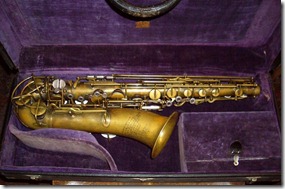 Scott Granlund of Granlund Woodwind Repair is a world class musician and repair tech. Recently he shared this story on Facebook and I wanted to get it out to my many friends who are not Facebook users. Those readers on Facebook can LIKE GWR on Facebook and view many more pictures with detail of the instrument as it is taken apart and repaired.
Scott Granlund of Granlund Woodwind Repair is a world class musician and repair tech. Recently he shared this story on Facebook and I wanted to get it out to my many friends who are not Facebook users. Those readers on Facebook can LIKE GWR on Facebook and view many more pictures with detail of the instrument as it is taken apart and repaired.
Scott sez, “A woman called, wanted me to rebuild her great-grandfathers C melody saxophone. I said I’d look at it, see what could be done. She shows up later, opens the case and I exclaimed “So, your great-grandfather was Allen Loomis?!?” to which she replied, “Yes, he was”. And so began the odyssey of re-padding the Loomis C melody. Take a look, you’ll never see another one.” Pictures owned by Scott Granlund, click on picture for enlargement.
 Allen only made one C Melody which was more or less the prototype for the altos. The family has been asked a few times and at the present has no interest in donating to a collection. Here’s a link to info researched by Prof. James M. Borders and Stearns staff who report that Allen actually made eight instruments in total including this C Melody. Here is what they say about the alto sax in the Sterns collection.
Allen only made one C Melody which was more or less the prototype for the altos. The family has been asked a few times and at the present has no interest in donating to a collection. Here’s a link to info researched by Prof. James M. Borders and Stearns staff who report that Allen actually made eight instruments in total including this C Melody. Here is what they say about the alto sax in the Sterns collection.
Description: This instrument, patented by Allen Loomis of Toledo, Ohio, in 1920, was intended to serve as a prototype for the production of a new type of alto saxophone by the Conn musical instrument company. Of the several designers employed by the Conn design laboratory, Allen Loomis was known for his innovative, often outrageous instrument design. While his models often did incorporate many mechanical and acoustical improvements, they were frequently dismissed as too impractical to be put into production. It is speculated that Loomis never played a musical instrument in his life. Loomis was born in Jackson, Michigan; as an inventor, he received an 1899 patent for an automobile transmission, again, without any experience in the field.
This Alto Saxophone in E Flat (curved) is made of brass with silver-plated touches and rollers. He called it the “Double Resonance” model because it allows two or more tone holes to open below the key pressed. It is also known to technicians, due its mechanical complexity, as “The Watchmaker’s Dream”. Weighing 4 pounds more than a modern Saxophone, it has twenty-six brass keys including third octave key and low A extension (L4 roller). The instrument incorporates numerous mechanical and acoustical improvements including relatively small diameter tone holes and many keys having been relocated. The serial number is 6 (Loomis is known to have made eight instruments in total).
I’ll leave you with some more pictures to remind you that there are many more like these on the Granlund Woodwind Repair site on Facebook.













Allen Loomis was my grandfather. He definitely played the flute — We used to play Kindersymphonie on New Years Eve and I remember him playing flute then. I also remember him playing the fife, According to my mother, he played 3d bassoon in one concert of the Detroit Symphony, possibly during World War I. He had an extensive collection of “freak” woodwind instruments, most of which went to the University of Michigan after his death in 1948.
What a magical and fascinating fellow Allen Loomis must have been. And to have him as a grandfather, how precious. Thank you for sharing!